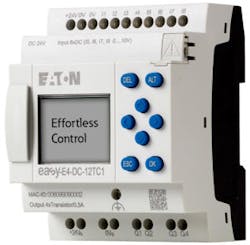Q&A: Nano PLCs simplify industrial water system monitoring
Describe the important role PLCs play in control systems.
Programmable logic controllers(PLCs) are microprocessor-based devices used to control industrial processes or machines. They provide advanced functions, including monitoring, control and communications to share data over networks.
PLC’s simplify water control systems by reducing complexity and improving flexibility in control systems.The expanding features of PLCs used to increase efficiency allow operators more data and analytics at their fingertips.
What are common challenges or misconceptions faced when selecting or specifying the technology?
There are many misconceptions about which type or class of device to use. Automated water systems generally have multiple solutions to a problem.Operators can use discrete proportional integral (PI) controllers, or use device level control such as a variable frequency drive (VFD) to regulate a pump. It is a difficult task to balance the cost and capability needed for a solution.While discrete components offer reliable simple control, they often lack the configurability or expandability needed to meet changing requirements. Using a PLC reduces these hurdles, and using a nano PLC means more capability without increases in cost or complexity.
Talk a little bit about the impact of PLC size on control system design and what "nano" means.
A nano PLC is a very small PLC that often uses a "brick" form factor, which is a low-profile panel mount modular package compared to a rack mounted solution that has a base module and slots for slice option cards.Intelligent relays were launched as simple-to-use relay devices for replacing timers, counters and relays. These devices have evolved, retaining their easy-to-use programming while gaining functionalities such as process control and mathematical operations that have moved them to the nano PLC class.
Nano PLCs typically are smaller and less powerful than their micro, or small brothers. The I/O count used to be the deciding factor on when a higher class was needed, but this has been eliminated with new expandable designs.
If a control application does not require high-speed position control or precision, or the ability to control multiple devices over industrial communications, a nano controller could be a solution to save space and cost.
How do the advanced functionalities of the nano PLCs benefit water applications?
Using a nano PLC offers scalability to include simple protections such as temperature monitoring or more advanced functions such as monitoring pump efficiency to check for blockages and send warnings and maintenance reminders to a SCADA system or email the technician directly.
Courtesy of Eaton
How is the technology advancing control system flexibility and scalability?
Wider voltage ranges reduce the number of options and increase the flexibility of a single part number, which makes the product easier to choose, integrate and maintain.
Eaton’s series of ultra-compact, intelligent PLCs help advance energy management across industries. The new easyE4 is a globally rated nano PLC ideal for lighting, energy management, industrial control, irrigation, pump control, HVAC and home automation applications. The technology includes the smallest PLCs available incorporating advanced functionality. A range of features allows the PLC to support flexible control systems that are efficient and easy to implement.
Using the EasyE4 as a pump controller enables users to replace simple PI controllers. The ability to add 11 expansion modules to a single base unit allows for a more simplified and tailored solution to meet a specific control need. Additional voltages can be mixed and matched allowing more flexible and scalable solutions.
Adam Bainbridge is the product manager automation and micro drives, Industrial Control Division at Eaton.

